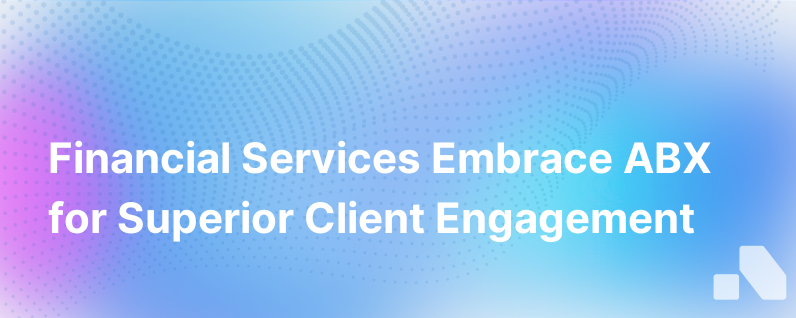Why Financial Services Firms Are Turning To Abx
Published on August 10, 2023 by Sawyer Middeleer
In the ever-evolving landscape of the financial services industry, where customer expectations are skyrocketing and competitors are only a click away, businesses must adapt and refine their marketing strategies to stay ahead. Enter Account-Based Experience (ABX), the latest buzzword to hit the sector, representing a strategic approach that combines the personalization of Account-Based Marketing (ABM) with customer experience strategies to forge deeper relationships with key accounts.
Financial services firms are increasingly turning to ABX as customer-centricity becomes the linchpin of business success. This methodology isn't merely a fleeting trend—it's a paradigm shift in how financial services firms interact with their most valued clients.
The Winning Formula: Personalization Meets Customer Experience
The financial services industry thrives on trust and personalized advice. Whether we're talking about wealth management, insurance, banking, or institutional investing, the most successful firms are those that treat their clients not as numbers but as individual entities with unique needs and preferences.
ABX builds on this by fusing personalized marketing with exceptional customer experience at every touchpoint. How? By leveraging data analytics and AI to deliver tailored content and engagement strategies that resonate with individual clients at scale.
The Four Pillars of ABX in Financial Services
1. Data-Driven Insights: Harness the power of data analytics to drive deep insights into customer behavior and preferences. By sifting through vast datasets—from transaction history to online interactions—financial firms can tailor their approach to match customer needs. Such targeted messaging helps nurture leads more effectively, fostering growth and loyalty.
2. Integrating Technology: ABX relies heavily on cutting-edge technology. CRM platforms, marketing automation tools, and data analytics systems intertwine to create a seamless ecosystem that delivers the ABX strategy. For example, AI-driven tools can predict the next best action with a client, whether it's a personalized email or an invitation to an exclusive webinar, based on their interaction history.
3. Cross-Functional Collaboration: In the ABX model, sales, marketing, and customer service are not siloed teams; they're part of a unified front. Aligning goals and strategies across these teams ensures that customers receive a consistent, high-quality experience. Whether a client is talking to a salesperson or a support agent, they get the same level of personalized service.
4. Lifecycle Engagement: The client journey doesn't end with a closed deal. ABX emphasizes continuous engagement, nurturing clients through personalized, relevant content and interactions throughout their lifecycle. In financial services, this means regular check-ins, market updates based on the customer’s interest, and advice on aligning their portfolio with changing financial goals.
The ABX Advantage in Numbers
Financial service firms that have adopted ABX report superior outcomes across the board:
- Enhanced client acquisition: ABX can increase conversion rates by aligning marketing resources to target key accounts systematically, ultimately attracting high-value clients.
- Up-sell and cross-sell opportunities: Existing clients are more likely to expand their portfolio when offered personalized services that clearly demonstrate value.
- Strengthened client retention: Personalized client experiences yield higher satisfaction rates, reducing churn and solidifying long-term relationships.
- Optimized marketing ROI: By focusing on accounts with the highest revenue potential, financial services firms can maximize their return on marketing investment.
Real-Time ABX: A Case Study
Consider a wealth management firm that adopted an ABX strategy. By implementing advanced data analytics, the firm could segment its clientele not only based on the traditional AUM (Assets Under Management) but also aligning service models to the client engagement level and preference.
For high engagement clients interested in sustainable investing, the firm crafted customized monthly reports on ESG (Environmental, Social, and Governance) market trends and aligned their investment strategies accordingly. More traditional, less engaged clients received quarterly industry outlooks and an annual personalized review. Throughout the lifecycle, every client touchpoint was tailored and consistent, resulting in expanded accounts and improved retention rates.
Overcoming Challenges with ABX
The transformation to an ABX strategy doesn't come without its challenges. Privacy concerns, regulatory compliance, and internal resistance to change can impede progress. Financial firms must navigate these issues by building robust data governance frameworks, providing comprehensive staff training, and fostering a culture that embraces innovation.
The path to a successful ABX implementation lies in recognizing that it's not just about technology or marketing—it’s about aligning with core business values of trust, personalization, and exceptional service to align deeply with clients' expectations and needs.
Conclusion
As the competitive landscape of financial services continues to intensify, firms are increasingly turning towards ABX to differentiate themselves. In a world where personal relationships and customer loyalty are paramount, ABX stands out as a strategic solution that perfectly aligns with the core principles of the financial services industry.
The implementation of ABX delivers a competitive advantage, one that resonates with clients on a personal level and cements your firm's reputation as a forward-thinking, client-centered organization. It's more than just a marketing trend; it's the evolution of client engagement, and financial services firms are wise to take note.